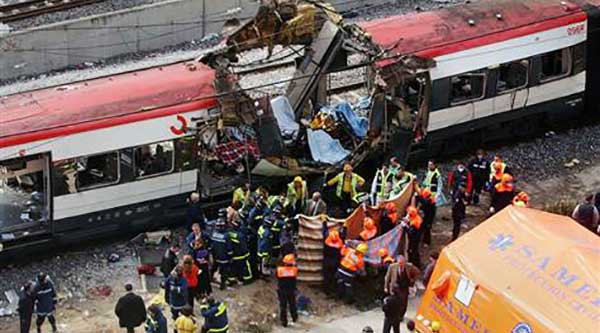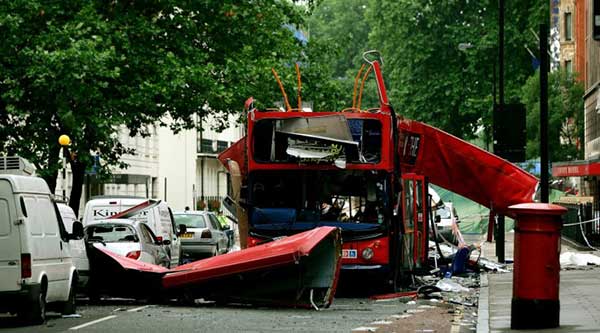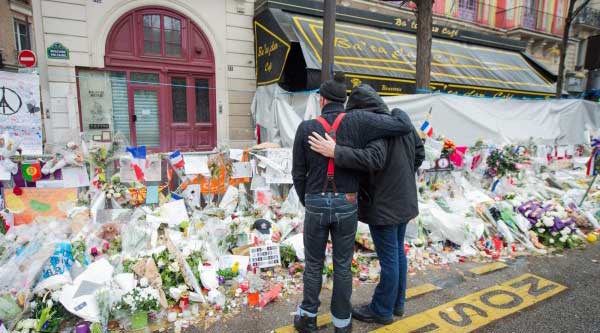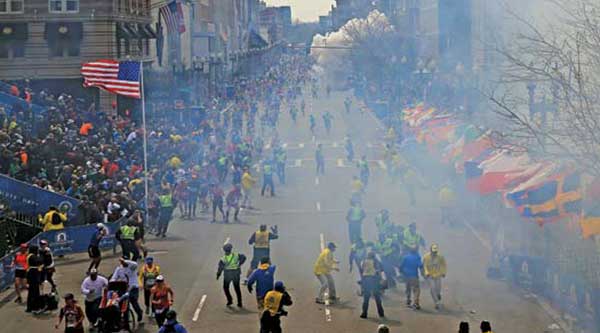Al-Qaeda and ISIS’s operatives and lone-wolf supporters have long targeted crowded areas in the West in an effort to maximize civilian casualties. Such targets have included concerts, cafes, nightclubs, malls, sporting events, and transportation systems such as busses and metros. While both al-Qaeda and ISIS seek to exact revenge on the countries fighting them, ISIS targets Western civilians primarily in order to kill the “disbelievers” until they “submit to the authority of Islam,” as proclaimed in the fifteenth issue of Dabiq. (Source: Dabiq, p. 31)
Al-Qaeda
Al-Qaeda has largely justified its killing of civilians as retribution for Western intervention in Muslim lands. In a letter to the West in 2002, Osama bin Laden wrote that “…anyone who kills our civilians, then we are going to kill their civilians.” The al-Qaeda founder also argued that civilians in the West are culpable of offences—such as electing political leaders who carry out interventions in Muslim lands—and are thus deserving of death. Bin Laden explained: “It is a fundamental principle of any democracy that the people choose their leaders, and as such, approve and are party to the actions of their elected leaders...This is why the American people are not innocent. The American people are active members in all these crimes.” (Sources: Guardian, Alex J. Bellamy, Massacres and Morality, p. 359)
These rationalizations echo one of bin Laden’s first fatwas, issued in 1998. He wrote, “The ruling to kill the Americans and their allies—civilians and military—is an individual duty for every Muslim who can do it in any country in which it is possible to do it….” The following year, in an interview with Esquire magazine, bin Laden reiterated his point: “[Al-Qaeda does] not differentiate between those [Americans] dressed in military uniforms and civilians; they are all targets….” (Sources: Federation of American Scientists, Esquire)

(Source: Inspire p.70)
More recently, in the spring 2016 issue of Inspire, al-Qaeda laid out its justification for killing Western civilians. While claiming that the death of civilians is not the group’s priority, al-Qaeda wrote that killing non-combatants would raise awareness of the target population as to “their governments crimes [sic];” punish the politicians who perpetrate those “crimes;” and “[cut] the hands” of those waging wars in Muslim countries. The group further justified its practice of killing civilians by writing: “tit for tat is a fair game… They drop hellfires, we start wildfires.” (Source: Inspire, p. 45)
Al-Qaeda’s attacks in the West have predominantly targeted civilians. From the group’s abandoned plot to release cyanide in the New York subway system in 2003, to the thwarted plot in 2006 to bomb the PATH commuter train connecting New York and New Jersey, al-Qaeda has apparently sought to maximize civilian casualties. In addition, al-Qaeda’s successful largescale attacks in the West—including the Madrid bombings in 2004 and the London bombings in 2005—have also apparently followed bin Laden’s edict to exact revenge for Western intervention. (Sources: New York Times, New York Times, Washington Post, Inspire, p. 45, Inspire)

Wreckage from the March 2004 Madrid train bombings
(Source: AP)
Transportation
The Madrid attacks in March 2004 are a prime example in which al-Qaeda chose its target—the city’s commuter train—in an apparent effort to maximize civilian casualties. In the early morning of March 11, coordinated bombings on four commuter trains killed 191 people and injured more than 1,800 others. In so doing, al-Qaeda sought to punish the Spanish government and its citizens for Spain’s participation in the U.S.-led intervention in Iraq. The group swiftly claimed responsibility for the bombings, writing that the attacks were in response to Spain’s “collaboration with [U.S. President George] Bush and his allies.” One month after the bombings, bin Laden issued a message to the West at large, saying, “What happened on 11 September [2001] and 11 March [the Madrid train bombings] is your commodity that was returned to you.” (Sources: CNN, BBC News, BBC News)
The month following the bombings, newly appointed Spanish Prime Minister and strident war opponent Jose Luis Rodriguez Zapatero pulled Spanish troops out of Iraq. Zapatero anticipated that the United Nations would fail to take over postwar occupation in June, a condition he had previously demanded in order to stay in the war. Analysts decried Zapatero’s move, labeling it a win for al-Qaeda. Then-Sen. John Warner, R-Virginia, said, “I hope al Qaeda does not misinterpret this.” (Sources: CNN, NBC News, Heritage)
Al-Qaeda sought to send a similar message to England when the group claimed responsibility for the London bombings the following year. On July 7, 2005, al-Qaeda-affiliated operatives targeted civilians on three subways and one bus in an attack that left 52 people dead. In its claim of responsibility, al-Qaeda wrote that it had targeted the “British Zionist Crusader government,” and that the group had “repeatedly warned the British Government and people.” Unlike the Spanish government, the British government did not pull its troops from Iraq following the attack. The United Kingdom carried out combat operations in Iraq until 2009, and officially withdrew forces from Iraq in 2011. (Sources: BBC News, BBC News, BBC News, Metro)
Al-Qaeda has since continued to call for attacks in crowded public areas, encouraging attacks in affluent neighborhoods in particular. In November 2016, al-Qaeda released an issue of Inspire magazine praising the September 2016 bomb attacks in New York and New Jersey. The group surmised that bomber Ahmad Khan Rahami planted the IEDs in crowded locations in the area since New York is “the economic capital of America,” noting that Manhattan is “considered as the most important suburb in it [New York].” As al-Qaeda wrote, Manhattan “is the administrative and economic center of New York. The importance of the Chelsea neighborhood is seen in the class of residents who live there, majority of them are notables and upper class. Therefore, if a well-known restaurant had been targeted there during a weekend definitely one of the very important persons would have been affected.” Following the attack, al-Qaeda encouraged its sympathizers to “target America,” directing followers to “[s]elect areas where there are large crowds.” (Source: Inspire, p. 7-10)

The bombed double-decker bus in central London
(Source: Rueters)
ISIS
While al-Qaeda targets Westerners, and Americans in particular, using a variety of ideological and strategic justifications, ISIS’s reasons for targeting those individuals may be more straightforward. Unlike al-Qaeda, ISIS targets Western civilians primarily because they deem those civilians to be kuffar. While ISIS has other political motives similar to al-Qaeda—such as seeking revenge for Western intervention—ISIS has openly claimed to kill Western civilians because they hold that Muslims have been commanded to fight the “disbelievers” until they submit to Islam. (Source: Dabiq, p. 31)
In its July 2016 issue of Dabiq, ISIS wrote that the group despises and fights Westerners “first and foremost because you are disbelievers; you reject the oneness of Allah….” In one article, titled “Why We Hate You & Why We Fight You,” ISIS clarified that “even if” the Western countries ended their military campaigns against ISIS, the terror group would only enact a short-term ceasefire “to focus on the closer and more immediate threats, before eventually resuming our campaigns against you.” (Source: Dabiq, p. 31)
While ISIS seeks to kill “disbelievers” in every country around the world, the group’s late spokesman Abu Muhammad al-Adnani also called on Muslims to kill the citizens of those countries participating in the U.S.-led coalition against ISIS. In his September 2014 speech “Indeed Your Lord is Ever Watchful,” Adnani declared, “If you can kill a disbelieving American or European – especially the spiteful and filthy French – or an Australian, or a Canadian, or any other disbeliever from the disbelievers waging war, including the citizens of the countries that entered into a coalition against the Islamic State, then rely upon Allah, and kill him in any manner or way however it may be.” In September 2016, in claiming responsibility for a stabbing spree in St. Cloud, Minnesota, carried out by American citizen Dahir Adan, ISIS said that Adan had “carried out the operation in response to the [call to attack] citizens of countries belonging to the [international] coalition [against ISIS].” (Sources: Long War Journal, Star Tribune)
By targeting citizens of coalition countries, ISIS may be seeking to avenge its operatives killed in coalition airstrikes. Although the terror group seeks to ultimately goad Western armies into an apocalyptic battle in Dabiq, in the near team ISIS may be seeking to simply drive coalition militaries from its territory so the caliphate can regroup, re-organize, and expand. (Source: Long War Journal)
ISIS has prioritized the killing of civilians both in the territories it controls and the territories it does not. The terror group’s operatives and lone-wolf supporters have carried out attacks against civilians in a number of Western countries, most notably in France, Belgium, Germany, the United Kingdom, and the United States. (Source: New York Times)
ISIS carried out a large-scale attack in Paris in November 2015 in an apparent attempt to murder civilians and target a country participating in the U.S.-led coalition. On the evening of November 13, 2015, eight ISIS operatives used suicide bombs and assault rifles to target numerous crowded, enclosed areas in Paris and its environs, including a football match at the Stade de France, multiple cafes, and a concert at the Bataclan theater. The attack left 130 people dead and more than 350 wounded. In its claim of responsibility—released on Twitter and Telegram—ISIS referred to France as the “capital of prostitution of obscenity,” and wrote that the targets had been “accurately chosen.” (Sources: BBC News, Sun, SITE Intelligence)
Concert Halls and Nightclubs
ISIS gunmen killed 89 people when they opened fire at concertgoers at the Bataclan. Following the attacks, ISIS lauded the attacks on the Bataclan theater in particular, where the group said “hundreds of apostates had gathered in a profligate prostitution party.” Also in reference to the Bataclan, in its 12th issue of Dabiq, ISIS wrote that the theater had been filled with “hundreds of French mushrikīn [polytheists].” On the evening of May 22, 2017, a suicide bomber targeted the entrance of the Manchester Arena in England, where pop singer Ariana Grande had been performing to a crowd of 20,000 people. Claiming the attack on May 23, 2017, ISIS said that one of its “soldiers of the caliphate” had placed bombs in a “gathering of crusaders” in Manchester. Thousands of teenagers and children were in attendance. (Sources: SITE Intelligence, Dabiq, p. 28, Sky News, Fox News)
By all accounts, ISIS appears to have targeted crowded locations in an attempt to maximize civilian causalities and “punish” Western countries for airstrikes in Syria and Iraq. The group has also targeted nightclubs for terrorist attacks. On June 12, 2016, ISIS supporter Omar Mateen carried out the deadliest mass shooting in U.S. history, killing 49 people at Pulse, a gay nightclub in Florida. Following the attack, ISIS referred to Mateen as a “mujahid” and one of the “soldiers of the Caliphate,” asserting that he had targeted what the group called a “Crusader nightclub” and “a nightclub for sodomites.” ISIS also claimed responsibility for the Istanbul nightclub shooting on New Year’s Eve, 2017. Following the attacks, ISIS asserted in its January 2017 Rumiyah issue that the attack in Istanbul was justified since nightclubs were “temples of shirk [idolatry].” (Sources: SITE, Dabiq, p.30, 43 Rumiyah, p. 12-16)
Transportation
In March 2016, four months after the Paris attacks, three ISIS suicide bombers targeted Brussels’ Zaventem airport and Maelbeek metro station, killing 32 people and injuring hundreds more. The attack began at the airport at approximately 7:00 GMT, when two bombers struck at Zaventem airport, immediately killing 11 people. Approximately one hour later, the third bomber struck the middle car of a three-car train running through the Maelbeek metro station, near the city’s center. (Sources: BBC News, Independent)
Following the attacks, New York City’s transportation commissioner Polly Trottenberg warned that terrorists target transportation systems because “[that’s] where a lot of people are congregating…they make targets.” Alongside its claim of responsibility for the Brussels bombings, ISIS released an addendum justifying the killing of civilians in both the Brussels attack and the November 2015 Paris massacre. In the addendum, ISIS cited numerous Quranic verses that it claimed support its targeting of civilians, writing that “we want to make it clear to all that what makes the kafir’s [nonbelievers’] blood permissiable [sic] to spill is not him fighting the Muslims, rather it is his ‘KUFR’ that necessitates his killing.” In other words, ISIS views all nonbelievers as legitimate targets, whether or not they are directly involved in “fighting the Muslims.” Indeed, at the time of Brussels attack, Belgium was not a participant in the U.S.-led coalition against ISIS. The country joined the coalition in May 2016. (Sources: Politico, Heavy, International Business Times)
On December 11, 2017, a suspect identified as 27-year-old Akayed Ullah detonated a pipe bomb in the New York City subway system beneath the New York Port Authority Bus Terminal during morning rush hour. The bomb reportedly exploded prematurely, wounding Ullah and three bystanders. Police arrested Ullah and authorities labeled the incident an attempted terror attack. Ullah was reportedly inspired by ISIS but had no direct contact with the group, according to initial reports. (Sources: CBS News, Associated Press)
Outdoor Venues
ISIS’s call to kill civilians was answered again on July 14, 2016, when Tunisian-born Mohamed Lahouaiej-Bouhlel drove a 19-ton refrigerated truck into a crowd of people celebrating Bastille Day in Nice, France, killing 86 people and wounding more than 400 others. Calling Lahouaiej-Bouhlel “one of the soldiers of the Islamic State,” ISIS claimed that the attack was carried out “in response to calls to target nationals of states that are part of the coalition fighting [ISIS].” One day later, al-Qaeda’s Inspire published a special release on the attack. Without mentioning ISIS, al-Qaeda lauded the attack as an “Inghimaasi (plunging deep into enemy lines) operation,” and described Lahouaiej-Bouhlel as a “[hero] of Lone Jihad.” With regard to the specific target—the Promenade des Anglais, a long stretch of road—the militants wrote that “this was not randomly selected. He chose a place where there were huge crowds of people existed [sic].” (Sources: BBC News, Guardian, Inspire)

Members of “Eagles of Death Metal”—the band playing at the Bataclan Conference Center during the November 2015 Paris attacks—return to the concert hall the following month
(Source: Getty Images)
The release also mentioned the specific timing of the attack: “As for his choice on the day of the operation - Bastille Day - a day where many citizens flock to the streets thus giving him a wide range of targets.” Targeting the city of Nice in particular was “appropriate,” according to al-Qaeda, as Nice is “known for its racist views and right wing extremism,” as well as what al-Qaeda claims is Nice’s enmity toward Muslims. The attack came two years after al-Qaeda had itself called for attacks on French Bastille Day military parades, in the group’s spring 2014 issue of Inspire. Nearly six years before the Nice attack, al-Qaeda had urged followers to use a truck to “inflict maximum carnage.” In its October 2010 issue of Inspire, the group explicitly wrote that attackers should “[g]o for the most crow[d]ed location” and “pick up as much speed as you can” in order “strike as many people as possible”—recommending a 4WD pickup truck as a suitable weapon. The group wrote: “In fact if you can get through to ‘pedestrian only’ locations that exist in some downtown (city center) areas, that would be fabulous.” (Sources: Inspire, Inspire, p. 71, Inspire, p. 54)
The July 2016 Bastille Day attack was followed by a similar attack in Berlin in December of that year. On December 19, 2016, Tunisian-born Anis Amri plowed a truck into a crowd of people at a Christmas market in Breitscheidplatz, a major public square in Berlin near the landmark Kaiser Wilhelm Memorial Church. The attack killed 12 people and injured 48 others. Witnesses say that Amri jumped the sidewalk and careened into the crowd of market-goers at an estimated 40 miles per hour. One of the attack’s victims, a Polish man, was found stabbed and shot to death in the truck’s passenger seat. ISIS swiftly claimed responsibility for the attack, calling Amri a “soldier” of the Islamic State. In its January 2017, issue of its Rumiyah magazine, ISIS wrote that Amri had acted “in response to the Islamic State’s call to target the citizens of nations involved in the Crusader coalition, which is killing Muslims.” Previously, in its November 2016 issues of Rumiyah, ISIS had instructed followers to carry out vehicular attacks that would target “large outdoor conventions and celebrations, pedestrian-congested streets, outdoor markets, festivals, parades[, and] political rallies.” ISIS has reiterated its call to carry out vehicular terrorist attacks in propaganda materials released in mid-2017. In the May 2017 issue of its online magazine Rumiyah, ISIS called for truck attacks targeting “Large Outdoor Festivals, Conventions, Celebrations, and Parades.” (Sources: Guardian, Wall Street Journal, Rumiyah, p. 41, Rumiyah, p. 11-12, Rumiyah, p. 56)
On October 31, 2017, Uzbek immigrant Sayfullo Saipov drove a rented Home Depot truck onto a bicycle path along New York City’s West Side Highway for approximately 20 blocks. Saipov struck several people before he drove into a school bus, killing at least eight and wounding at least 12. Police shot and arrested Saipov after he exited the truck carrying a paintball gun and a pellet gun. Police found handwritten notes near the truck attributing the attack to ISIS, and Saipov was reportedly linked to social media accounts that posted ISIS-related material. The attack took place hours before and only a few blocks away from New York City’s annual Halloween parade, which attracts more than two million people. Mayor Bill de Blasio and Governor Andrew Cuomo later attended the parade, which went on as planned with heightened security. (Sources: New York Times, CNN, Wall Street Journal, CNN)
Case Study: Boston Marathon Bombings
On April 15, 2013, brothers Dzhokhar and Tamerlan Tsarnaev detonated two homemade pressure-cooker bombs at the crowded finish line of the Boston marathon in Massachusetts. The explosions left three people dead and more than 250 wounded, 17 of whom lost limbs as a result of the attacks. (Sources: Boston Globe, New York Times)

Scene at the Boston bombings (Source: The Boston Globe/AP)
Al-Qaeda praised the Boston bombings in its May 30, 2013, issue of Inspire. The magazine quoted U.S. Representative Bill Keating (D-Mass.) as saying, “[the Tsarnaev brothers] chose symbolic targets…the oldest marathon that brings people together from all around the world….” Lending further explanation regarding the choice of location, al-Qaeda wrote that the brothers’ targeting of Boston was “appropriate” due to the city’s relative insignificance in comparison to New York, which has been “under an intensive security surveillance since September 11.” The bombers targeted Copley Square, “the substantial heart of Boston center,” according to al-Qaeda. (Source: Inspire, p. 21)
In a manifesto scrawled on the inside of the boat where Dzhokhar Tsarnaev was found by police, the terrorist gave his own explanation for the attack, writing that “the U.S. Government is killing our innocent civilians but most of you already know that.” The brothers had initially planned to target a Fourth of July celebration, but, according to Dzhokhar Tsarnaev, chose the well-known marathon as a “target of opportunity” after they completed their bomb-making faster than expected. (Sources: Boston Globe, Runner’s World, Boston Globe)
After the Boston Marathon bombings, al-Qaeda urged American jihadists to carry out more attacks, specifically naming the “New York City Subway or any other soft target” as ideal choices. (Source: Inspire, p. 31)